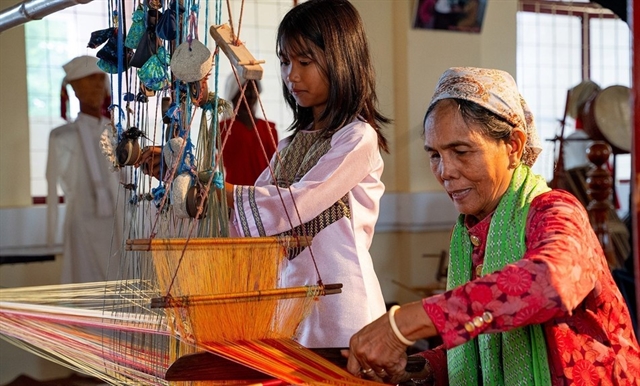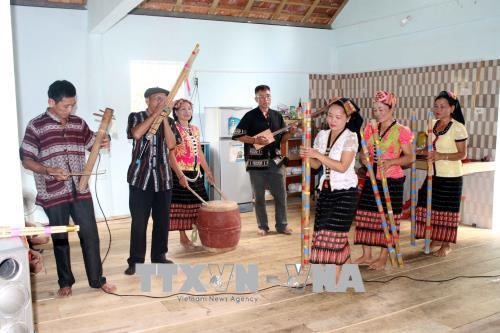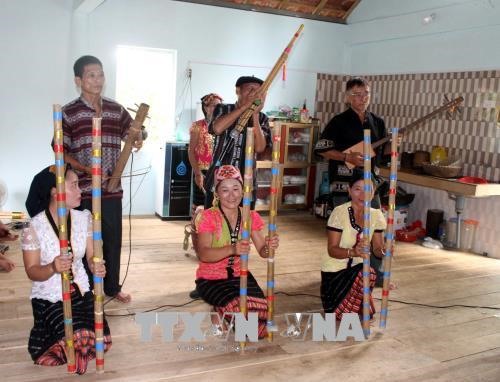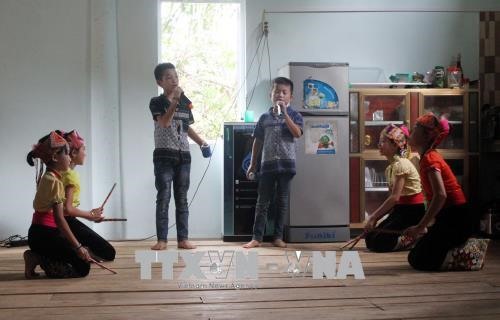 Features
Features

For members of art clubs in Con Cuông District in the central province of Nghệ An, performing Thai folk songs and dances is not only for entertainment but also helps preserve the traditional style of music.
 |
| Playing together: A performance of Thai folk music and dance by members of the Cằng Village Thai folk art club in the central province of Nghệ An’s Con Cuông District. — VNA/VNS Photo Tá Chuyên |
by Tá Chuyên
NGHỆ AN — For members of art clubs in Con Cuông District in the central province of Nghệ An, performing ethnic Thai folk songs and dances is not only for entertainment but also helps preserve the traditional music.
The members of 19 Thai folk music clubs across the district are making a great contribution to preserving Thai folk music in the province, according to a local culture official.
Nguyễn Xuân Nam, head of the district’s Culture and Information Unit, said the clubs, part of a project to preserve and develop traditional culture, were actively helping to boost tourism in the region.
“With the operation of such clubs, spiritual life and cultural activities in localities have been significantly improved. The clubs have also helped eliminate backward customs in many remote villages,” said Nam.
According to the official, among the clubs in Con Cuông District, the one in Cằng Village, Môn Sơn Commune has been the most successful at preserving various Thai folk music, dances and songs including the lam vông (circle dance), and quạt (fan dances) that are unique dances of Việt Nam’s ethnic Thai people.
Every Saturday evening, about 40 members of the Cằng club gather at the village’s communal culture house to talk, cheer and practice playing traditional instruments and singing folk songs.
The members, from the oldest of 65 years old to the youngest of 8, all share a fascination with the songs.
Established in February 2010 with only 14 members, the club now has been expanded to 40. Many of them are young people who can perform Thai dancing and singing at a high level.
Thai folk music master Lương Văn Nghiệp, 62, founder of the Cằng Village’s music club, said Thai music plays a very important role in local cultural life.
“Thai traditional music, including dances and songs, appear in a variety of activities involving both work and entertainment. We, the local people, the old and young, women and men, can sing songs in our own language, while farming in the field, cooking in the kitchen or playing on the yards,” said Nghiệp.
“At annual festivals in particular, Thai music, songs and dances with their soft tones, beautiful words and joyful gestures are always the centre of all culture performances,” he added.
The artist said he had admired the musical art since he was a child sitting by his grandparents who were performing in groups after hardworking days in the rice fields.
His love for Thai folk songs led him to pledge to learn how to perform them.
With support from his grandparents and other elderly people in the village, when Nghiệp was 15, he could play various traditional instruments and perform the folk songs of the Thai.
But nowadays, Nghiệp said, Thai songs and dances were facing the risk of fading away due to a decrease in the number of Thai performers.
“I created the initiative to establish Thai folk music clubs to help preserve such a valuable part of our ethnic culture,” the artist said.
Nghiệp first used his house as a place for the club members to gather for singing.
He tried to convince as many people as possible from the most elderly to the youngest child in the village to come to his home to attend the club, which offers some classes teaching Thai music, songs and dances.
Lô Văn Huân, the youngest member of the club at 8 years old, said he was always excited to learn the folk songs.
 |
| Powerful sounds: Thai folk music clubs are making a great contribution to preserving Thai folk culture in Nghệ An Province. |
 |
| Next generation: Beautiful Thai folk songs attract the attention of many children in Con Cuông District, Nghệ An Province. |
Huân said he was happy to be member of the club because it offers a chance for him to understand his ethnic traditions.
To improve the qualifications of the members as well as encourage them to maintain their inspiration for the folk songs and dances, the club also organises contests and exchanges knowledge and experience with others clubs in the district, according to Nghiệp.
Members themselves also write new songs using original Thai tunes and adding more modern lyrics to make the songs relatable to current daily life.
Nghiệp and other members of the club held a programme to search for and collect ancient instruments among the Thai people such as the khèn (panpipe), pí (flute), đàn nhị (two-string fiddle) and đàn tính (gourd lute).
To preserve and promote the value of Thai traditional music, members of the Cằng Village music club opened their own class for producing instruments and teaching songs and dances to local people.
About 30 students selected from the primary and secondary schools have been taught about Thai folk music for one month every year since 2015.
The Nghệ An Province’s People’s Committee has certified the club as one of the most successful models for cultural preservation in the province.
Nghiệp, who founded the club in 2015, has been awarded the title of "National Meritorious Artist" in recognition of his contributions to preserving Thai folk music.
Con Cuông District in the mountainous area bordering Laos is home to seven ethnic groups, of which the Thai make up 75 per cent of the total population.
The district’s cultural authority has implemented special policies to support such clubs, including investment in performing and training programmes for local people. — VNS




